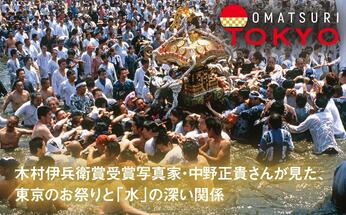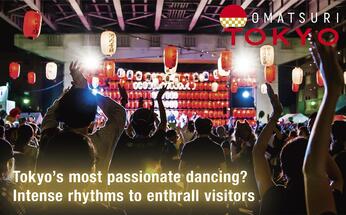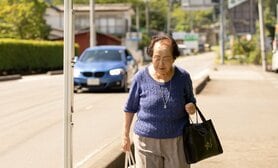
【PR】【Vol.25】木村伊兵衛賞受賞写真家・中野正貴さんが見た、東京のお祭りと「水」の深い関係
* * *
日本人は古来から山や川、海といった森羅万象すべてに神が宿ると考え、それら大自然と神様に感謝を捧げる儀式として祭りを始めるようになったので、火や水が重要な役割を果たす祭りが多いように思う。東京にも水にまつわる祭りがいくつかあって、品川区の荏原(えばら)神社例大祭、別名「かっぱ祭り」はその移動距離の長さから言っても都内有数のスケールを誇る。
江戸時代の前半、船に乗った村人が海に漂っていた素戔嗚尊(すさのおのみこと)の神面を拾い、荏原神社に納めた。だが、神主が夢の中で「海から拾ったものだから、年に一度、海上を渡らせなさい」とお告げを受ける。神輿の上にお面をつけて海を渡ったところ、その年は大漁だったということから、毎年、豊漁・豊作を祈って行われるようになった。
僕が撮影した時は、洲崎橋の袂(たもと)から目黒川を下り東京湾を横切ってお台場海浜公園にたどり着き、若衆が威勢のいいお囃子(はやし)にあわせてお面の付けられた神輿を海中で担ぎ、大声を張り上げながら供養と祈願をするという流れで執り行われていた。担ぎ手達が数十隻の釣り船に分散し一斉に東京湾を渡る様子は、戦国時代に大量の船で出陣するかのような迫力で、人々の気合の入り方も尋常ではなかったと記憶している。
この種の祭りからはいつもそういった真剣勝負のようなヒリヒリとした緊張感と、集団 から生まれた巨大なエネルギーが大気中に放出され、神通力のようなものが強く感じられる。
もう一つの水に関わる祭りが富岡八幡宮の例大祭である。別名「水掛け祭り」の名のとおり水しぶきが派手に飛び散る祭りで、大小合わせて120 基の神輿が通るたびに沿道から清めの水が次々と大量に掛けられるのだが、逆光に輝く水しぶきと、担ぎ手の体から湯気となって立ち上る様子は実に美しい。渡御道程(神輿が通る道)では消防団がホースで水を浴びせる大胆なシーンにもお目にかかれ、見ている側も一緒にずぶぬれになり清められたような気分になってくる
僕は写真を撮っていていつも水には畏敬の念を抱いているが、それは海や川といった大 自然の水を撮影する場合に限らず、こういった水しぶきの水滴を撮る際にも同様に感じる ことだ。地球を地球たらしめているのはもちろん水の所在によるところなので、崇高なもの であることに異論はないであろうが、それが神を祀る祭りと結びつくことでよりいっそう荘厳 で神秘的なものに感じられるのだろう。
写真・文:中野正貴
1955年、福岡県生まれ。翌年から東京在住。79年、武蔵野美術大学造形学部視覚伝達デザイン学科卒業。80年からフリーランスとして活動し、各種広告、雑誌表紙などを手がける。2000年、無人の東京を撮影した写真集『TOKYO NOBODY』 (リトルモア)を発表し、映画や文学にも影響を与え話題となる。翌年、日本写真協会賞新人賞を受賞。05年、建物の窓から東京の特徴を捉えた写真集『東京窓景』 (河出書房新社)により、第30回木村伊兵衛写真賞を受賞。19~20年には東京都写真美術館で写真展「東京」を開催。
http://www.artunlimited.co.jp/artists/masataka-nakano.html
本企画は『東京の魅力発信プロジェクト』に採択されています。
このサイトの情報は、すべて2019年8月現在のものです。予告なしに変更される可能性がありますので、おでかけの際は、事前にご確認下さい。
→英語版はこちら(English version)

























